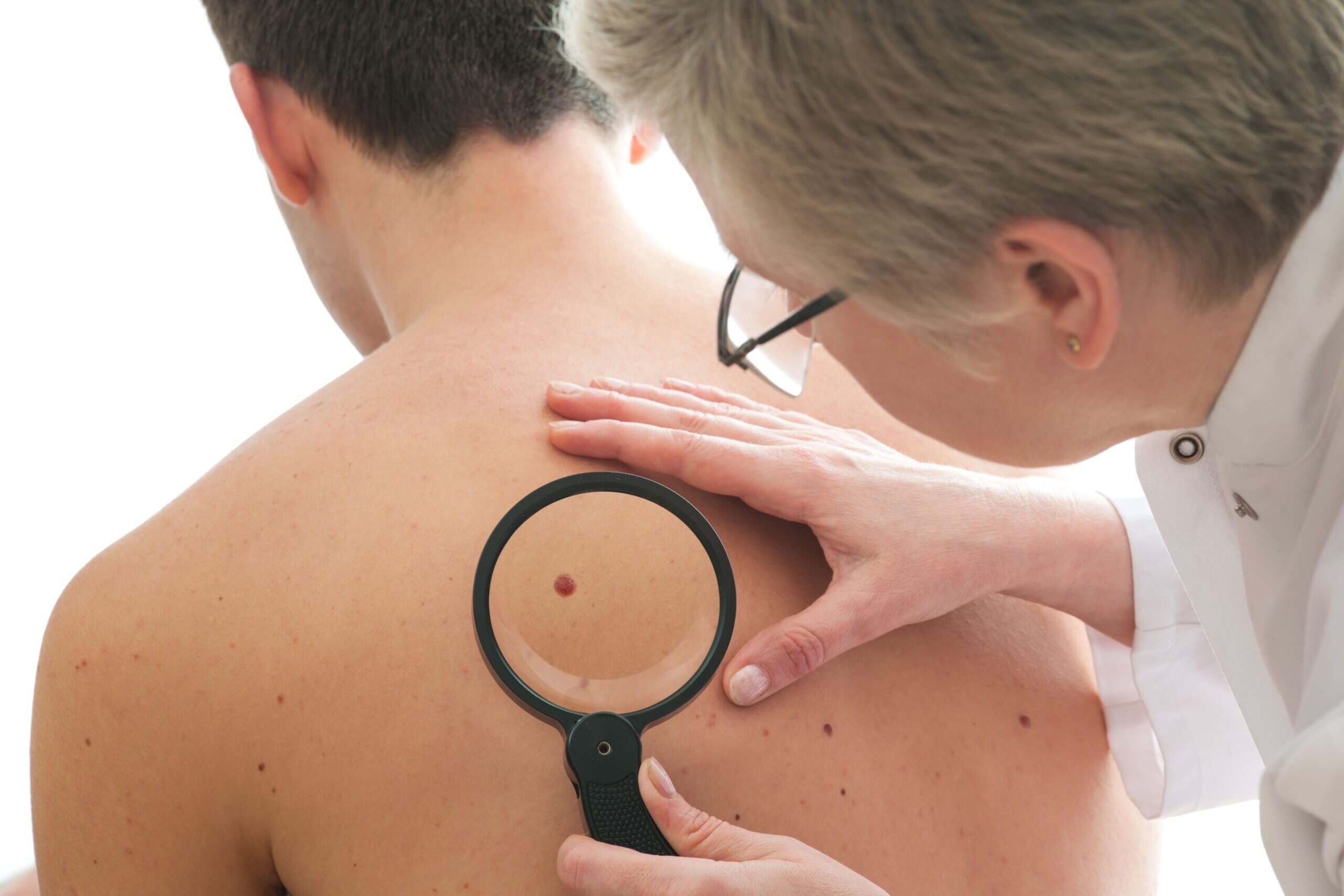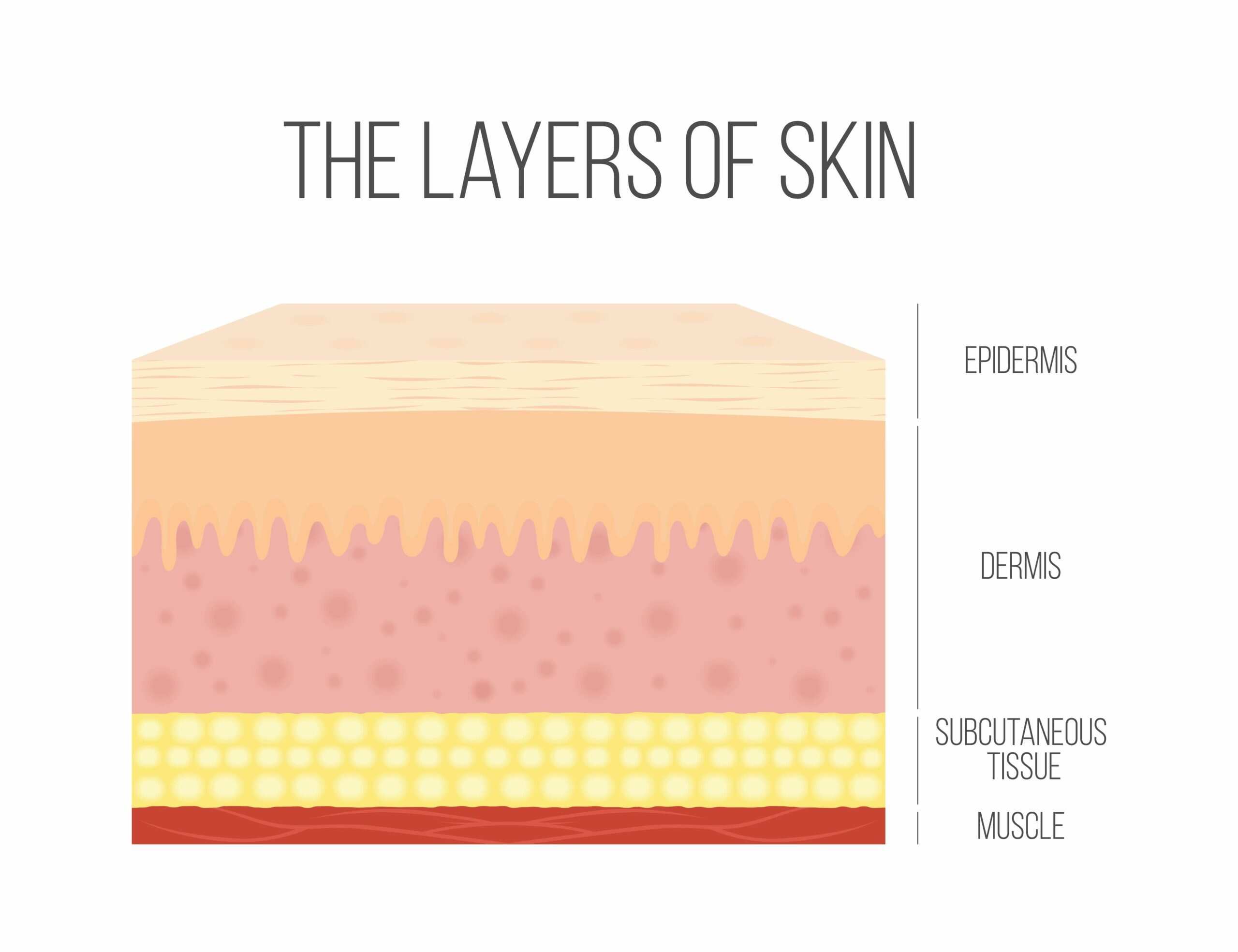Types of Skin Cancer and Treatments

Anyone can get skin cancer, no matter their skin color. You can get skin cancer even if you never sunburn.
The Layers of Skin

- Squamous Cells: These are thin flat cells that form the top layer of the epidermis.
- Basal Cells: These cells are round cells found under the squamous cells.
- Melanocytes: These cells are found in the lower part of the epidermis. Melanocytes make melanin, the pigment that gives skin its natural color.
Types of Skin Cancer
The most common types of skin cancer are basal cell carcinoma, squamous cell carcinoma, and melanoma.
Basal cell and squamous cell carcinomas, also known as non-melanoma skin cancers, are the most common forms. They arise within the top layer of skin and frequently appear on any sun-exposed area of the body, including the face, ears, bald scalp, and neck. While these skin cancers may grow slowly, if left untreated, they can grow deep and spread to the nearest lymph nodes, through the blood to bones, the lungs, and other parts of the skin.
Melanoma is the deadliest form of skin cancer, as it can spread to lymph nodes and most internal organs. It is easier to cure when found in its early stages before spreading to the dermis.
In addition to these three main types, there are other, less common types of skin cancer, including Merkel cell carcinoma, dermatofibrosarcoma protuberans, and various rare skin cancers.
To learn more about Mohs surgery click here. View a list of Mohs surgeons here.
Overall, all skin cancers are highly curable when detected and treated in their early stages.
Basal Cell Carcinoma
Basal cell carcinoma is the most common type of skin cancer. It most often develops in people with fair skin but can also develop in people of color. It usually develops after years of frequent sun exposure or indoor tanning.
Signs of Basal Cell Carcinoma
Basal cell carcinoma usually looks like
- A flesh-colored round growth
- A pearl-like bump
- A pinkish patch of skin
These signs of basal cell carcinoma usually appear on the head, neck, arms, chest, abdomen, back, and legs.
With early diagnosis, basal cell carcinoma is treatable. If you fail to get treatment for basal cell carcinoma, cancer can grow deep and penetrate the nerves and bones, causing damage and disfigurement.
Squamous Cell Carcinoma
Squamous cell carcinoma is the second most common type of skin cancer. It most often develops in people who are fair skin but can also develop in people with skin of color.
Signs of Squamous Cell Carcinoma
Squamous cell carcinoma usually looks like
- A red firm bump
- A scaly patch
- A persistent sore that doesn’t heal or heals and reopens
These signs of squamous cell carcinoma usually tend to form on skin that gets frequent sun exposure, such as the rim of the ear, face, neck, arms, chest, and back.
Squamous cell carcinoma can also grow from precancerous skin growths called actinic keratoses (AKs). AKs are dry, scaly patches or spots that commonly affect fair-skinned people. They usually appear on the head, neck, hand, and forearms. AKs aren’t skin cancer, but they can grow into squamous cell carcinoma if left untreated. Cryotherapy and photodynamic therapy (blue or red light treatment) effectively treat AKs.
With early diagnosis, squamous cell carcinoma is treatable. If you fail to get treatment for squamous cell carcinoma, cancer can grow deep and spread to other areas of the body over time.
Melanoma
Melanoma is the most deadly form of skin cancer because it spreads to lymph nodes and most internal organs more readily. Melanoma can occur anywhere on the body but often appears on the upper back, torso, lower legs, head, and neck. Learn more about melanoma here.
To learn more about Mohs surgery click here. To view our Mohs surgeons here.
Signs of Melanoma
Melanoma can develop in a mole or suddenly appear as a new dark spot on the skin.
The ABCDEs of Melanoma
Knowing the ABCDEs of Melanoma can help you detect melanoma during self-examination.
A is for Asymmetry. One half of the spot is unlike the other half.
B is for Border. The spot has an irregular, scalloped, or poorly defined border.
C is for Color. The spot has varying colors from one area to the next, such as shades of tan, brown, or black, or areas of white, red, or blue.
D is for Diameter. Melanomas are usually greater than 6 millimeters or about the size of a pencil eraser; however, they can be smaller if diagnosed early.
E is for Evolving. The spot looks different from the rest or changes in size, shape, or color.
Early diagnosis and treatment are critical as melanoma is the deadliest form of skin cancer.
Merkel Cell Carcinoma
Merkel cell carcinoma is a rare, potentially aggressive form of skin cancer of neuroendocrine origin. It primarily affects older male patients (>50 years old) with lighter skin and has a high rate of spread/metastasis. MCC is thought to originate after a specific virus (Merkel cell polyoma virus) infects cells in the lower portion of the epidermis. It most commonly is found in the head and neck area but can be found almost anywhere on the skin.
Symptoms include firm, shiny, 1-2cm blue/red bumps under the skin that rapidly enlarge. It can be asymptomatic in many cases, which can lead to a delay in diagnosis. The crusting and bleeding that is seen in many other forms of skin cancer is less common in Merkel cell carcinoma.
To learn more click here.
Risk Factors for Skin Cancer
You may be more at risk for developing skin cancer if
- You have fair skin.
- You seldom use sunscreen or wear sun-protective clothing.
- You have a history of sunburns.
- You use tanning beds.
- You have precancerous growths (actinic keratoses, AKs). Some AKs progress, turning into squamous cell carcinoma.
- You have a history of HPV infection of the mouth, genitals, or anus.
Prevalence of Skin Cancer In the US
According to the American Academy of Dermatology Association (AAD), skin cancer is the most common cancer in the US, affecting one in five Americans in their lifetime.
Research estimates show that:
- Nonmelanoma skin cancer (NMSC), including basal cell carcinoma (BCC) and squamous cell carcinoma (SCC), affects more than 3 million Americans a year; and
- More than 1 million Americans are living with melanoma. About half of melanomas are self-detected.
Survival Rates
- Basal cell and squamous cell carcinoma are highly treatable if detected early and treated properly.
- According to the American Cancer Society, 5-year relative survival rates for melanoma skin cancer are as follows:
-
- The 5-year survival rate for people whose melanoma is detected and treated before it spreads to the lymph nodes is 99 percent.
- The five-year survival rate for melanoma that spreads to nearby lymph nodes is 68 percent.
- The five-year survival rate for melanoma that spreads to distant lymph nodes and other organs is 30 percent.
Mortality Rates
- The vast majority of skin cancer deaths are from melanoma.
- Nearly 20 Americans die from melanoma every day.
Skin Cancer Detection
The ADA encourages everyone to perform regular skin self-exams to check for signs of skin cancer. Check out the ADA’s “How To Spot Skin Cancer” infographic to check your skin regularly.
When To See A Dermatologist
Contact Schweiger Dermatology Group if you notice a spot on your skin that:
- Differs from the others
- Changes
- Itches
- Bleeds
Call (844) DERM-DOC to schedule an appointment today or book your appointment online with one of our top dermatology providers.
Diagnosing Skin Cancer
Your dermatologist will examine your skin for any suspicious-looking spots during your consultation. If any spots that may look like skin cancer are detected, your doctor will perform a skin biopsy to remove the spot or part of it to send to the lab for evaluation.
The tissue sample will be looked at under a microscope and checked for cancer cells at the lab. If cancer cells are found, the type will be indicated in the biopsy report.
If melanoma cells are seen, the biopsy report will indicate the type of melanoma, how deep the melanoma tumor has grown into the skin, and how quickly the melanoma cells are growing and dividing. When possible, the stage of disease will also be indicated.
If no cancer cells are found, the biopsy report will also indicate that.
Sometimes cells are found that are not cancerous but are considered “precancerous” or pose a higher risk of turning into skin cancer. In these instances, your dermatologist will discuss with you whether further treatment is necessary.
Treatment Options for AKs or Precancerous Lesions
Freezing or Cryotherapy. Cryotherapy can be performed during an in-office visit. It involves spraying an extremely cold substance (e.g., liquid nitrogen) on the skin to destroy precancerous cells.
Light Therapy or Photodynamic Therapy (PDT). PDT is typically used to treat AKs. It is a two-part process. First, a solution that makes your skin more sensitive to light is applied to AKs and a bit of skin around it. You’ll sit with this solution on your skin for one to several hours. Second, your skin is treated with a blue or red light to kill the precancerous lesions.
Treatment for Skin Cancer
If your lab report indicates you have skin cancer, your dermatologist will recommend a treatment option based on the type of skin cancer you have, where it is located, and how deeply cancer has grown.
There are both nonsurgical and surgical treatment options available for skin cancer, some of which include:
Nonsurgical Treatment Options for Skin Cancer
Medications. Medications can be applied to the skin at home as prescribed either as an initial treatment (applied to the skin cancer to help reduce the size of the cancerous tumor) or as a secondary treatment (applied after another treatment to kill any remaining cancer cells). Two drugs approved by the FDA for such treatment include Imiquimod and 5-FU.
Radiation Therapy. For radiation treatments, you’ll need to go to a hospital or treatment center for several treatments given over a period of several weeks. This may be the only treatment recommended, or it could be a secondary treatment to kill any remaining cancer cells. Radiation treatment is usually only recommended for patients 60 years or older.
Surgical Treatment Options for Skin Cancer
Surgical Removal. Surgical removal of skin cancer can be done in the office while you remain awake. A topical anesthetic is used to numb the area. There are three types of surgical removal used to treat skin cancer.
- Excision. The skin cancer and the surrounding area of normal skin are removed. Removing some normal skin is necessary to ensure that all stray cancer cells are removed. Your dermatologist will then look at this tissue under a high-powered microscope to ensure that the area of margin removed is free from cancer cells. If any normal-looking skin is found to have cancer cells, you will be referred to have more treatment, MOHs surgery.
- MOHs Micrographic Surgery. MOHs surgery allows for the selective removal of tumors to preserve as much of the surrounding normal tissue as possible. It offers the highest chance for complete removal of cancer while sparing normal tissue because it precisely maps the location of cancer. The cure rate for new cancers with the MOHs procedure can exceed 97 percent.
View Mohs surgeons here. - Curettage and Electrodessication. Skin cancer is removed from your skin using a technique called curetting. Then electrodesiccation is used to destroy any remaining cancer cells with heat. This procedure is not performed in areas of heavy hair growth, such as the scalp, a man’s beard area, or an armpit.
For melanoma that has grown deeper into the skin or has spread, your dermatologist will recommend additional treatments after surgery to eradicate any remaining cancer cells.
Skin Cancer Prevention
For skin cancer prevention, the ADA recommends the following:
- Stay out of indoor tanning beds
- Protect your skin from the sun’s harmful UV rays by seeking shade
- Wear protective clothing
- Wear a wide brim hat
- Use a broad-spectrum, water-resistant sunscreen with an SPF of 30 or higher
- Reapply sunscreen every 2 hours, especially when outdoors or when swimming or sweating
- Perform regular skin self-exams
- Consider using a self-tanning product
Skin Cancer Treatment Near You in NY, NJ, PA, CT, FL, IL, MN and MO
If you suspect you may have a suspicious spot or mole that may be skin cancer, call Schweiger Dermatology Group at (844) DERM-DOC to schedule an appointment for proper diagnosis and treatment.
To view our Mohs surgeons here.
Skin Cancer FAQs
-
What does skin cancer look like?
Skin cancer can appear on the body in many different ways, including:
- A changing mole or mole that looks different from your others
- A dome-shaped growth
- A scaly patch
- A non-healing sore or sore that heals and returns
- A brown or black streak under a nail
-
How do you know if a spot is skin cancer?
The ADA encourages everyone to perform regular skin self-exams to check for signs of skin cancer. Click here to view information on how to spot skin cancer.
-
Can skin cancer kill you?
Malignant melanomas are highly aggressive cancers that can spread to other parts of the body. If not treated early, these cancers may be fatal.
-
How quickly does skin cancer grow?
Melanoma can grow quickly and can become life-threatening within 6 weeks after detection. Early diagnosis and treatment are essential.
-
Does skin cancer go away on its own?
No, skin cancer doesn’t go away on its own. You will need treatment to remove the cancerous cells from your skin. The longer you delay treatment, the cancer cells can grow deeper, injuring nerves, blood vessels, and anything else in its path. As the cancer cells pile up, a large tumor can form. In the case of melanoma, cancer can spread to your lymph nodes and most internal organs. Melanoma is the deadliest of skin cancers. To view a list of Mohs surgeons click here.
-
What is the outlook for someone who has had skin cancer?
Skin cancer is curable when diagnosed and treated early. However, it is important to note that skin cancer can return, and you are at a higher risk of developing another skin cancer.
-
Is it essential to have yearly check-ups after having skin cancer?
Yes, it is highly recommended that you have regular skin checks after having skin cancer because once you have had skin cancer, you are at a higher risk of developing another skin cancer.
Generally, most patients with skin cancer should get skin checks every 3 to 6 months for the first 2 to 3 years after detection of skin cancer, then at least yearly after that. These recommendations, however, can vary depending on the type of cancer diagnosed.
